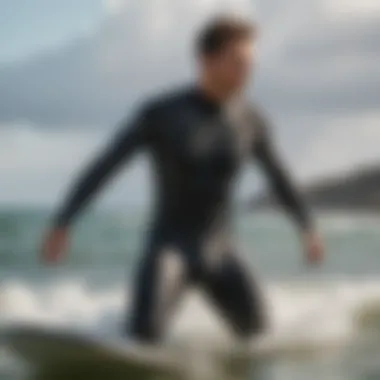Choosing the Best Gear: Dry Suit vs. Wetsuit for Kitesurfing and Kiteboarding


Equipment Reviews
When it comes to kitesurfing and kiteboarding, selecting the appropriate gear is paramount for both safety and performance. In this section, we delve deep into comparing the essential equipment - dry suits and wetsuits. Each gear type offers unique advantages and limitations, catering to diverse preferences and needs of riders.
Dry Suits: Shielding Against the Elements
Dry suits are designed to provide complete protection from cold water and harsh weather conditions. Constructed from waterproof materials such as neoprene or Gore-Tex, these suits offer insulation and keep the rider dry throughout their session. However, they may restrict movement slightly due to their bulkier nature, and proper fit is crucial for optimal performance and comfort.
Wetsuits: Flexibility and Comfort
Wetsuits, on the other hand, are known for their flexibility and comfort. Made from neoprene, these suits allow for greater freedom of movement, ideal for executing complex maneuvers on the water. While wetsuits do not provide the same level of warmth as dry suits, they are preferred in moderate climates or for riders who appreciate flexibility over insulation.
In the following sections, we will delve into the nuances of each gear type, exploring their functionalities, advantages, limitations, and how they align with the needs and preferences of kitesurfing and kiteboarding enthusiasts.
Introduction
When it comes to the exhilarating sports of kitesurfing and kiteboarding, the choice between a dry suit and a wetsuit holds significant importance. These gear options play a crucial role in ensuring comfort and safety while engaging in these water sports. Understanding the nuances between dry suits and wetsuits is essential for enthusiasts to make an informed decision based on their preferences and requirements. This article delves deep into the features, advantages, and disadvantages of both dry suits and wetsuits, offering valuable insights to aid individuals in selecting the most suitable attire for their kitesurfing and kiteboarding adventures.
Kitesurfing and kiteboarding demand gear that can withstand the elements and provide adequate protection against the water's chill. The choice between a dry suit and a wetsuit can impact not only the comfort level but also the overall performance and experience of the athlete. By navigating through the key points discussed in this article, individuals will gain a comprehensive understanding of the factors that differentiate dry suits from wetsuits and make an informed decision that aligns with their specific needs and preferences. Whether it's the insulation properties, mobility factors, or budget considerations, each aspect holds weight in determining the most suitable gear for kitesurfing and kiteboarding activities.
Embracing the world of kitesurfing and kiteboarding entails more than just mastering the techniques; it involves choosing the right gear that complements one's skills and goals. This introduction sets the stage for a detailed exploration of dry suits and wetsuits, shedding light on the intricacies of each gear type to empower enthusiasts with the knowledge necessary to embark on their water adventures with confidence and comfort.
Understanding Dry Suits
In the world of kitesurfing and kiteboarding, understanding dry suits holds paramount importance. Dry suits serve as a crucial gear choice for enthusiasts looking to maximize their performance and comfort while braving the elements. These specialized suits are designed to provide superior insulation and protection from cold waters, making them indispensable for riders seeking extended sessions in challenging conditions. By delving into the intricacies of dry suits, riders can navigate the waters with confidence and ease, knowing they are well-equipped to handle whatever the environment throws their way.
Features of Dry Suits
When exploring the features of dry suits, one encounters a myriad of innovative elements meticulously crafted to enhance the wearer's experience. From advanced neoprene or breathable membrane constructions to efficient seals at the cuffs and neck, every aspect of a dry suit is engineered to maintain optimal warmth and dryness. Additionally, features such as reinforced kneepads, integrated socks, and adjustable waistbands further contribute to the overall functionality and comfort provided by these garments, ensuring riders can focus entirely on their performance without any distractions or discomfort.
Pros of Using a Dry Suit


The advantages of using a dry suit in kitesurfing and kiteboarding scenarios are abundant and significant. One of the primary perks is the unmatched insulation they offer, allowing riders to conquer frigid waters without succumbing to harsh temperatures. Dry suits also provide exceptional buoyancy, crucial for staying afloat during maneuvers or emergencies. Furthermore, the ability to layer clothing underneath a dry suit adds versatility, enabling riders to adjust their attire based on changing weather conditions, ensuring sustained comfort throughout their sessions.
Cons of Using a Dry Suit
Despite their numerous benefits, dry suits come with certain drawbacks that riders must consider. The most notable limitation is reduced mobility compared to wetsuits. The relatively thicker and less flexible material of dry suits can hinder some movements, affecting agility and overall performance. Additionally, the initial cost of purchasing a quality dry suit may pose a barrier for budget-conscious riders. Proper maintenance and storage are also essential to prolong the lifespan of a dry suit, adding an extra layer of upkeep that riders need to account for in their routine.
Exploring Wetsuits
In the realm of kitesurfing and kiteboarding, the exploration of wetsuits holds significant importance. Wetsuits are a pivotal gear choice for enthusiasts of these water sports, providing a balance between insulation and mobility. Understanding the characteristics of wetsuits is essential for individuals seeking comfort and performance during their aquatic adventures. By delving into the specifics of wetsuits, riders can make informed decisions that align with their preferences and requirements.
Characteristics of Wetsuits
Wetsuits exhibit distinctive characteristics that set them apart in the realm of water sports gear. These suits are typically crafted from neoprene, a durable and flexible material that conforms to the body, ensuring a snug fit. The insulating properties of neoprene trap a thin layer of water against the skin, which the body then warms, providing thermal comfort in cold waters. Additionally, wetsuits offer varying thickness levels, ranging from 2mm to 6mm, catering to different water temperatures and personal preferences. The design of wetsuits often incorporates strategic seam placements to minimize water ingress and maximize flexibility, enhancing the wearer's range of motion.
Advantages of Wetsuits
Wetsuits extend a host of advantages to kitesurfers and kiteboarders venturing into the water. One primary benefit is their versatility across a broad spectrum of water conditions. From mild to chilly waters, wetsuits can adapt to varying temperatures, keeping athletes comfortable and protected. Moreover, the snug fit of wetsuits reduces drag and improves buoyancy, contributing to enhanced performance and energy conservation during water activities. The thermal insulation provided by wetsuits enables extended sessions in cold environments, prolonging the thrill of riding the waves.
Disadvantages of Wetsuits
Despite their numerous advantages, wetsuits also present certain limitations that enthusiasts should consider. One common drawback is the potential for chafing and skin irritation due to prolonged contact with wet neoprene. Additionally, entry and exit can be challenging, especially when dealing with tight-fitting wetsuits, requiring some effort and dexterity. While wetsuits offer thermal insulation, they can feel restrictive for some individuals, affecting mobility and flexibility during dynamic movements on the water. Understanding these drawbacks is crucial for kitesurfers and kiteboarders when evaluating gear options for their excursions.
Factors to Consider
Fit and Comfort
The fit of the suit is paramount as it affects mobility and insulation. A well-fitted suit minimizes water ingress, ensures proper movement range for performing tricks and maneuvers, and prevents chafing or discomfort during extended periods on the water. Evaluating the suit's fit based on personal body measurements and trying it on before purchase is essential to guarantee maximum comfort and functionality.
Insulation and Thermal Properties
Understanding the insulation and thermal capabilities of the suit is imperative, especially when kiting in colder waters. Dry suits are renowned for providing superior insulation by sealing the wearer completely from water contact, keeping the body warm in frigid conditions. Conversely, wetsuits utilize neoprene material that traps a thin layer of water against the skin, leveraging body heat to create a thermal barrier. Consider the water temperature of the kiting spot to determine the most suitable option for maintaining optimal body temperature.
Mobility and Flexibility


Mobility is key during kitesurfing and kiteboarding sessions, where agility and freedom of movement are prerequisites for executing stunts and maneuvers effectively. Dry suits, although offering great insulation, can restrict mobility due to their bulkier construction. In contrast, wetsuits provide greater flexibility and agility, ensuring unrestricted movements in the water. Assess the level of mobility required for your kiting style and the demands of different tricks to choose a suit that complements your performance needs.
Durability and Maintenance
Durability and maintenance are essential considerations when investing in a kitesurfing suit. Dry suits typically require more meticulous care to prolong their lifespan, including regular rinsing, proper storage, and occasional maintenance of seals and zippers. Wetsuits, while more resilient to wear and tear, also demand care, such as rinsing after each use and storage away from direct sunlight to prevent material degradation. Assess your dedication to maintenance routines and choose a suit that aligns with your commitment to preserving its longevity.
Buoyancy and Water Resistance
Buoyancy and water resistance properties vary between dry suits and wetsuits, affecting the rider's experience on the water. Dry suits provide additional buoyancy, aiding flotation, and potentially enhancing comfort when spending long hours kiteboarding. On the other hand, wetsuits offer minimal buoyancy but excel in water resistance, reducing the impact of wind chill and water flow on the body. Evaluate the importance of buoyancy and water resistance based on your skill level and the conditions you typically kite in to select the most suitable option for your needs.
Considering these factors in detail will guide kitesurfers and kiteboarders in making an informed decision when choosing between a dry suit and a wetsuit. By prioritizing fit, insulation, mobility, durability, and buoyancy, riders can optimize their gear selection to match their individual preferences and environmental conditions.
Choosing Based on Water Temperature
When it comes to kitesurfing and kiteboarding, selecting the appropriate gear based on water temperature is a critical decision that directly impacts your performance, comfort, and safety. The temperature of the water you'll be navigating through plays a significant role in determining whether a dry suit or a wetsuit is the ideal choice for your adventure. Understanding the implications of water temperature on your gear selection is paramount for optimizing your overall experience on the water.
In cooler water conditions, typically below 60 degrees Fahrenheit, a dry suit proves to be the superior option as it provides exceptional insulation and protection against the cold. The sealed design of a dry suit ensures that minimal water enters the suit, keeping your body dry and warm throughout your session. This insulation is vital in colder temperatures to prevent hypothermia and maintain your body's optimal performance while engaging in demanding water sports like kitesurfing and kiteboarding.
On the other hand, wetsuits are more suited for milder water temperatures ranging from 60 to 70 degrees Fahrenheit. Wetsuits function by allowing a thin layer of water to seep into the suit, which is then warmed by your body heat, creating a protective barrier between you and the surrounding water. This mechanism helps regulate your body temperature and provides a comfortable environment for extended periods in the water.
Factors such as wind chill, air temperature, and individual tolerance to cold also influence the decision between a dry suit and a wetsuit based on water temperature. Considering these variables alongside the primary water temperature will guide you in selecting the most suitable gear for your kitesurfing or kiteboarding escapades. By aligning your gear choice with the prevailing water conditions, you can enhance your performance, extend your time on the water, and ensure a safe and enjoyable experience.
Selecting According to Mobility Needs
When it comes to kitesurfing and kiteboarding, selecting your gear based on mobility needs is paramount. The agility and flexibility required in these extreme water sports demand gear that allows for a wide range of movement while providing the necessary protection against the elements and potential injuries. Mobility is not just about freedom of movement but also about responsiveness and ease of maneuvering in challenging conditions.
Elements to Consider
- Flexibility: A key factor in choosing between a dry suit and a wetsuit is the flexibility they offer. Dry suits, although providing excellent insulation, can be restrictive in movement due to their design and material. In contrast, wetsuits are more elastic and facilitate a broader range of motion, crucial when executing complex maneuvers on the water.
- Weight: The weight of the suit can influence mobility significantly. Dry suits are typically heavier than wetsuits due to the additional layers required for insulation. This extra weight can impede swift movement and tire the wearer more quickly, impacting performance. Wetsuits, being lighter, contribute to a more agile and less fatiguing experience on the water.
- Buoyancy: Another aspect affecting mobility is buoyancy. Dry suits tend to offer more buoyancy compared to wetsuits, which can affect the rider's ability to stay nimble and perform tricks. While increased buoyancy can be beneficial in certain situations, such as cold water where insulation and flotation are crucial, it may hinder quick and precise movements required in kitesurfing and kiteboarding.
Benefits of Choosing According to Mobility


By aligning your gear choice with your mobility needs, you enhance your overall performance and enjoyment of the sport. Opting for a suit that prioritizes freedom of movement allows you to push your boundaries, try new stunts, and improve your skills without being hindered by gear restrictions. A well-suited outfit not only enables you to master challenging maneuvers but also enhances your confidence on the water, leading to a more fulfilling and successful kitesurfing or kiteboarding experience.
Considerations for Mobility Needs
When making your selection based on mobility needs, consider factors such as
- Sport-Specific Design: Look for suits designed explicitly for kitesurfing or kiteboarding, ensuring they cater to the unique movement requirements of these sports.
- Material Quality: Opt for high-quality materials that offer both flexibility and durability, striking a balance between ease of movement and resistance to wear and tear.
- Fit and Size: Choosing a suit that fits properly is crucial for unrestricted movement. A well-fitted suit reduces drag, enhances comfort, and allows for seamless transitions between different maneuvers.
Ultimately, selecting gear that aligns with your mobility needs is crucial for optimizing your performance and enjoyment on the water. By focusing on flexibility, weight, and buoyancy, among other factors, you can make an informed choice that empowers you to fully immerse yourself in the exhilarating world of kitesurfing and kiteboarding.
Budget Considerations
When delving into the intricate world of kitesurfing and kiteboarding, one of the pivotal aspects that demand meticulous attention is budget considerations. Understanding the importance of meticulously planning your financial outlay is paramount. Budget considerations in this context encompass various elements that could significantly impact your overall experience and gear selection process.
Firstly, cost plays a pivotal role in determining whether to opt for a dry suit or a wetsuit. Dry suits, known for their excellent thermal insulation properties, often come with a higher price tag compared to wetsuits. This stark cost disparity may pose a critical decision-making juncture for enthusiasts striving to strike a balance between performance and affordability.
Secondly, the durability and longevity of the chosen gear are directly correlated with the allocated budget. Investing in a high-quality dry suit or wetsuit can potentially enhance your comfort and safety over an extended period, proving to be a sound financial decision in the long run. Conversely, opting for a budget-friendly option could compromise crucial features and impact the gear's longevity, necessitating frequent replacements.
Furthermore, considering the additional accessories and maintenance costs is imperative when assessing budget considerations. Some high-performance gear may require specialized care and upkeep, translating into supplementary expenses. Understanding these financial obligations beforehand aids in sculpting a comprehensive budget plan, aligning your financial resources with the requirements of your chosen gear.
Lastly, unraveling the intrinsic relationship between budget considerations and your personal preferences is pivotal. While cost-effective options may initially appear appealing, discerning athletes must evaluate whether compromising on quality aligns with their long-term goals and comfort requirements. Striking a harmonious balance between budget considerations and gear quality forms the crux of making a well-informed decision tailored to your individual needs and financial capacities.
Navigating the intricate realm of budget considerations when selecting between a dry suit and a wetsuit for kitesurfing and kiteboarding necessitates a judicious approach. By astutely assessing cost implications, durability factors, and alignment with personal preferences, enthusiasts can fashion a budget plan that optimally caters to their distinctive needs, ensuring a seamless and rewarding kitesurfing or kiteboarding experience.
Maintenance and Care
Maintaining and caring for your kitesurfing and kiteboarding gear is crucial to ensure its longevity and performance. In this section, we will delve into the essential aspects of maintenance and care, shedding light on why this topic is of utmost importance in our discussion.
Firstly, regular maintenance routines can significantly extend the lifespan of your equipment. Cleaning your dry suit or wetsuit after each use helps prevent salt buildup, deterioration of fabric, and the growth of bacteria. By following manufacturer guidelines on care, such as avoiding direct sunlight or using specific detergents, you can maximize the durability of your gear.
Moreover, proper care not only preserves your gear but also ensures your safety while out on the water. A well-maintained suit is less likely to develop leaks or malfunctions, reducing the risk of cold water exposure or accidents during your kitesurfing or kiteboarding sessions. Thus, investing time in meticulous care practices can directly contribute to your overall well-being and enjoyment of these extreme sports.
Additionally, considering the financial aspect, regular maintenance can save you money in the long run. Repairing minor damages promptly, such as small tears or loose seams, prevents them from escalating into more significant issues that may require costly repairs or replacements. By adopting a proactive approach to maintenance, you not only protect your investment in high-quality gear but also minimize unforeseen expenses that could disrupt your kitesurfing or kiteboarding plans.
Conclusion
In the realm of kitesurfing and kiteboarding, the decision between a dry suit and a wetsuit holds significant weight, impacting the comfort, performance, and safety of enthusiasts navigating the waters. This article has meticulously dissected the nuances of dry suits and wetsuits, shedding light on their distinctive features, advantages, and drawbacks. By delving into the specifics of each gear type, readers are equipped with a trove of information to steer their choice towards the most suitable option. The significance of this comparative analysis lies in its ability to empower individuals to make informed decisions tailored to their unique requirements and preferences.
Understanding the intricacies of proper attire selection is pivotal for individuals seeking to optimize their kitesurfing or kiteboarding experiences. Whether one prioritizes warmth, flexibility, mobility, or durability, the choice between a dry suit and a wetsuit dictates the comfort level and performance potential on the waves. Embracing the conclusion drawn in this article not only elevates gear selection but also nurtures a culture of informed decision-making within the community of water sports enthusiasts.







